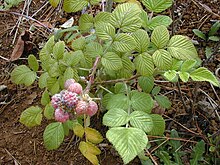| Rubus niveus | |
|---|---|

| |
| Scientific classification | |
| Kingdom: | Plantae |
| Clade: | Tracheophytes |
| Clade: | Angiosperms |
| Clade: | Eudicots |
| Clade: | Rosids |
| Order: | Rosales |
| Family: | Rosaceae |
| Genus: | Rubus |
| Species: | R. niveus |
| Binomial name | |
| Rubus niveus Thunb. 1813 (not Wall. ex G. Don 1832) | |
| Synonyms | |
Synonymy
| |
Rubus niveus (Mysore raspberry, Ceylon raspberry and Hill raspberry) is a species of Rubus. The native range of this scrambling shrub stretches from Afghanistan to central China, down to Java and Indo-China . It grows primarily in temperate regions.
Description
Rubus niveus is a shrub growing to 1–2.5 m (3 ft 3.4 in – 8 ft 2.4 in) tall, the stems whitish, tomentose (dense covering of short, matted hairs) at first, becoming glabrous green to purple later. The leaves are pinnate with 5–11 leaflets (mostly 7 or 9), the leaflets 2.5–8 cm (1.0–3.1 in) long and 1–4 cm (0.4–1.6 in) wide, with dark green above and densely pale grey to white tomentose beneath. The flowers are about 1 cm diameter, with five dark pink to red petals. The fruit is 8–12 mm (0.3–0.5 in) in diameter, densely grey tomentose, dark red at first, ripening black.
Taxonomy
It is commonly known as Mysore raspberry, Ceylon raspberry, and hill raspberry. It is called Chinese: 红泡刺藤 and Hindi: काला हिसालू, romanized: kala hinsalu in native and local languages.
It was first published by Carl Peter Thunberg in De Rubo: 9 in 1813.
There are 2 known varieties;
- Rubus niveus var. micranthus (D.Don) H.Hara
- Rubus niveus var. niveus
Distribution
It is native to southern Asia; from Afghanistan, east through India (Assam, East Himalaya, Nepal, Pakistan, Sri Lanka, and West Himalaya), and across to Tibet, southern and north central China and Taiwan. Then down to Indo-China (Laos, Myanmar, Thailand and Vietnam), to Malesia (in Java).
It has been introduced into various countries and regions including; south America (in Bolivia, southern Brazil, Ecuador, El Salvador, Guatemala, Nicaragua, Trinidad and Tobago), United States (in the states of Florida and Hawaii), Africa (Ethiopia, Galápagos, Kenya, Malawi, Tanzania, Zambia and Zimbabwe) and South Africa (in the Cape Provinces, the Northern Provinces and Swaziland).
It has become naturalised and invasive in Hawaii and the Galápagos Islands.
Cultivation
Rubus niveus is cultivated for its edible fruit. Rubus niveus berries have gastroprotective, antioxidant, and nutraceutical properties (Pancholi & Rana 2020).
References
- ^ "Rubus niveus Thunb. | Plants of the World Online | Kew Science". Plants of the World Online. Retrieved 30 October 2023.
- The Plant List, Rubus niveus Thunb.
- ^ Flora of China: Rubus niveus
- ^ "Rubus niveus". Germplasm Resources Information Network. Agricultural Research Service, United States Department of Agriculture. Retrieved 2 January 2018.
- University of Melbourne: Sorting Rubus names
- "Rubus niveus". Plants for a Future.
- Pacific Island Ecosystems at Risk: Rubus niveus
- Pancholi, B.; Rana, A.C. (2020). "Traditional uses, phytochemistry and pharmacological aspects of Rubus niveus thumb plant-A review". The Journal of Phytopharmacology. 9 (6): 438–444. doi:10.31254/phyto.2020.9610.
![]() Media related to Rubus niveus at Wikimedia Commons
Media related to Rubus niveus at Wikimedia Commons
| Taxon identifiers | |
|---|---|
| Rubus niveus |
|
This Rubus article is a stub. You can help Misplaced Pages by expanding it. |